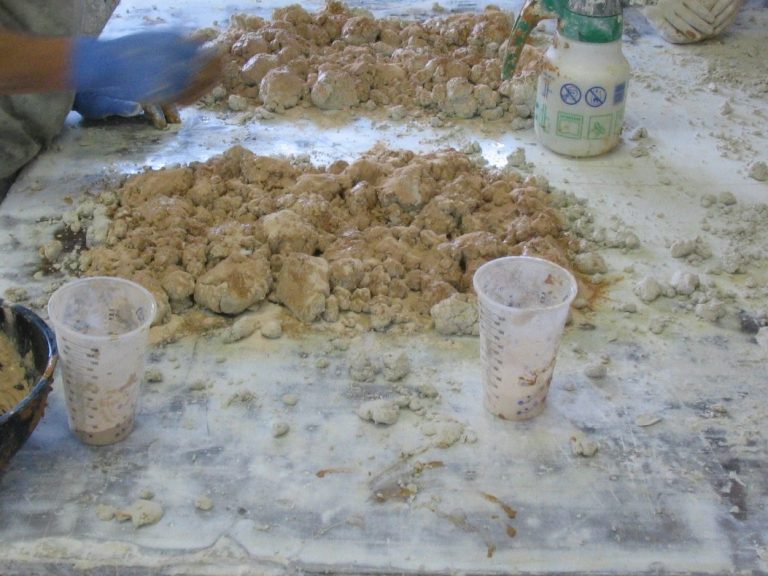
The History of Scagliola by Richard Feroze
Menu

Scagliola is an imitation marble made from a paste of gypsum plaster, water and pigments. The addition of glue to the water hardens the plaster. It also slows down the setting process allowing time for the paste to be sliced and pressed into moulds, or beaten onto prepared surfaces such as walls and column cores. Once the material has set hard, it is shaped and flattened using scrapers and abrasives. Holes and hollows are filled and grouted with fresh scagliola mixes. The surface is then polished using a series of progressively fine abrasives and re-grouting until a natural shine is achieved. At this stage the material is often sealed with linseed oil and wax, to enhance the depth of colour and provide surface protection.
The number and choice of colours and the different consistencies at which the individual pastes are mixed and blended give the material its richness and figuring and effect how closely the end product matches a given marble. The ability to make good scagliola relies on the knowledge and experience of the workshop and the recipes it has built up over the years. Technical, aesthetic and cost considerations must all be taken into consideration, and what works well in one situation may not in another.
Equally important is the polishing process, which is labour-intensive and time-consuming. One of the special qualities of scagliola is its natural shine, which is almost identical to that of polished marble. To achieve an even, scratch-free finish takes skill and care.
When making inlaid work, a flat slab of scagliola (or marble) is marked with a design and the areas to be inlaid are chased out and filled with the appropriate mixes; these can imitate marble and precious stones, or they can be used as individual colours to create ornamental and pictorial subjects. The inlays are left high and allowed to set before they are levelled and polished. The details of the design are built up through additional carving and filling operations, of which there may be many. The process is painstaking and once again experience comes into play.

Mixing scagliola on a bench
Polishing a column section on a lathe (Click on images to enlarge)
Carving, filling and cutting back inlaid scagliola lettering (Click on images to enlarge)
Scagliola is an imitation marble made from a paste of gypsum plaster, water and pigments. The addition of glue to the water hardens the plaster. It also slows down the setting process allowing time for the paste to be sliced and pressed into moulds, or beaten onto prepared surfaces such as walls and column cores. Once the material has set hard, it is shaped and flattened using scrapers and abrasives. Holes and hollows are filled and grouted with fresh scagliola mixes. The surface is then polished using a series of progressively fine abrasives and re-grouting until a natural shine is achieved. At this stage the material is often sealed with linseed oil and wax, to enhance the depth of colour and provide surface protection.

Mixing scagliola on a bench
The number and choice of colours and the different consistencies at which the individual pastes are mixed and blended give the material its richness and figuring and effect how closely the end product matches a given marble. The ability to make good scagliola relies on the knowledge and experience of the workshop and the recipes it has built up over the years. Technical, aesthetic and cost considerations must all be taken into consideration, and what works well in one situation may not in another.
Equally important is the polishing process, which is labour-intensive and time-consuming. One of the special qualities of scagliola is its natural shine, which is almost identical to that of polished marble. To achieve an even, scratch-free finish takes skill and care.


Polishing a column section on a lathe
When making inlaid work, a flat slab of scagliola (or marble) is marked with a design and the areas to be inlaid are chased out and filled with the appropriate mixes; these can imitate marble and precious stones, or they can be used as individual colours to create ornamental and pictorial subjects. The inlays are left high and allowed to set before they are levelled and polished. The details of the design are built up through additional carving and filling operations, of which there may be many. The process is painstaking and once again experience comes into play.
Carving, filling and cutting back inlaid scagliola lettering